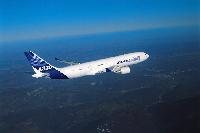Qantas and Airbus celebrated another major milestone in the airframe manufacturer’s relatively short but successful existence – the delivery of its 5,000th aircraft, an A330-200, to Qantas at a special ceremony in Toulouse.
Established in 1921, Qantas is one of the world’s oldest airlines, yet it only became an Airbus customer in November 2000, when it placed an order for 12 A380s and 13 A330s. Today, the Qantas Group, including Jetstar, has a fleet of 37 Airbus aircraft comprising ten A330-300s, seven A330-200s and 20 A320s. Also on order are 20 A380s and three A330s. In November, Qantas also announced its intention to acquire a further 50 A320 Family aircraft.
Accepting delivery of the new aircraft in Toulouse, Qantas Executive General Manager – Airlines, John Borghetti said, „We congratulate Airbus on reaching this major milestone in its history. Qantas has always been an industry leader when it comes to identifying the right aircraft at the right time for its fleet requirements. The A330 was the first Airbus type to fly under the Qantas brand and by 2009 the Qantas Group will operate a fleet of 22 A330s. The A330 and more recently the A320 have become integral to the Qantas Group’s investment and growth strategy, which is based on maximum flexibility and efficiency for our flying businesses.“
„This is an historical day for Airbus and the aviation industry in general, and I am delighted that Qantas, is here to share it with us,“ said Airbus President and Chief Executive Officer, Tom Enders. „After a slow start, Airbus went from strength to strength, developing a highly successful airliner family which is well established on the market place. The success of this family is also reflected by our very strong backlog of more than 3,000 aircraft including the all new A380 and A350. This gives us great confidence in the future“.
Thirty three years ago, in May 1974, Airbus delivered its very first aircraft, an A300B2, to first operator Air France. Nineteen years later, in 1993, Airbus delivered its first 1,000th aircraft, and it took it another six years to reach the 2000th in 1999. Reflecting its subsequent rapid growth with an expanded aircraft family and more products on offer, the 3,000th Airbus aircraft was delivered in 2002, and only three years later, in September 2005, the 4,000th. It needed only another two years to reach the 5,000th delivery milestone of today. Also, it took Airbus more than 30 years to deliver more than 50 per cent of all airliners of more than 100 seats delivered in one year. This was in 2005, and Airbus continued in the lead since. It also took Airbus some 30 years after its initial creation in 1970 to bypass it main competitor in terms of sales and remain constantly at around half the market share, with more than 50 percent for five years in a row since 2001.
Airbus continues to considerably ramp up its production rates so as to reach ten A330/A340, 40 A320 Family planes and four A380s per month by 2010 in order to cope with very strong demand for its products. Its backlog of more than 3,000 aircraft should be delivered within the next five to six years only.
Airbus‘ modern and comprehensive product line comprises five highly successful families of aircraft ranging from 107 to 525 seats: the single-aisle A320 Family (A318/A319/A320/A321), the wide-body A300/A310 Family, the long-range wide-body A330/A340, the all-new next generation A350 XWB Family, and the ultra long-range, double-decker A380 Family. Airbus‘ unique family concept ensures that Airbus fly-by-wire aircraft share the highest possible degree of commonality in airframes, on-board systems, cockpits and handling characteristics, which reduces significantly operating costs for airlines. To-date more than 8,000 Airbus aircraft have been ordered by more than 280 customers.
Photo: airbus/retouching serpal Airbus S.A.S. 2005 ©







